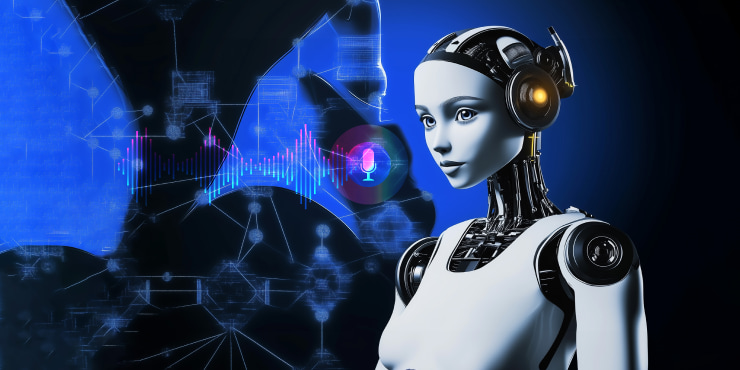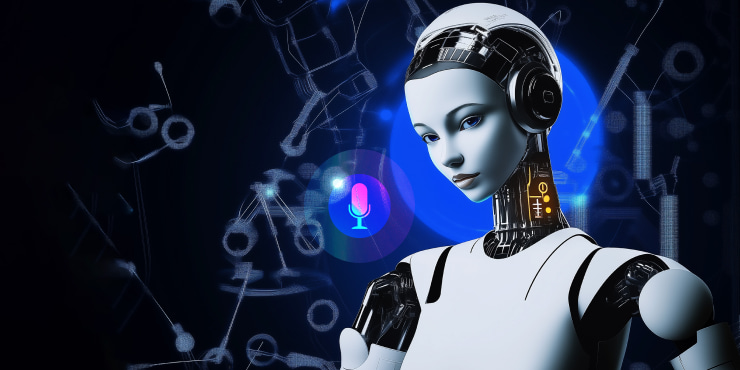Exploring the World of AI Robot Voice Technology

Automation of routine operations, where robots handle tasks instead of humans, is a growing trend. Many processes are automated, including telephone conversations with clients. Modern technologies can improve the capabilities of robots and continue to develop rapidly. We will talk about technologies that recognize the gender of the interlocutor. It happens through voice analysis and key conversational elements. Robot voice systems were limited to basic, mechanical tones with lack warmth and clarity. These early virtual voices often sounded stiff and impersonal, they made interactions with machines feel disconnected.
The evolution of artificial intelligence (AI) has led to remarkable advancements. They power today’s robot voice software. Automated systems become more intuitive and engaging. The impact of AI on virtual voice technology is widespread. It revolutionizes industries from customer service to entertainment, healthcare, and education. AI-driven voices enhance user experiences by making them more human-like, accessible, and efficient. They transform the way we communicate with machines.
How AI Robot Voice Technology Works
AI-powered voice technology combines advanced techniques, including text-to-speech (TTS), natural language processing (NLP), and deep learning algorithms. These technologies create lifelike, human-like speech, here’s how to make AI voices:
- Text-to-Speech (TTS): This foundational technology behind computer voice synthesis. The TTS system converts written text into spoken words. It involves breaking down text into phonemes. The TTS also consists of generating corresponding speech sounds. It ensures the output sounds natural and intelligible.
- Natural Language Processing (NLP): This technology enables AI to interpret human language. It analyzes the text's structure, meaning, and context. NLP allows the computer voice to generate appropriate and relevant speech responses. It helps the system understand syntax, grammar, and slang or regional dialects. NLP improves the accuracy of interactions.
- Deep Learning Algorithms: These techniques are employed to train AI models. This happens on large datasets of human speech. Such algorithms allow them to recognize tone, rhythm, and intonation patterns. They process vast amounts of audio data. These algorithms help improve the quality and naturalness of the AI's voice.
- Contextual Understanding: AI can process context. It ensures that the voice delivers relevant responses. They are based on previous interactions or current conversations. This contextual awareness helps it sound less robotic and more human-like. It improves user experience.
Virtual voice technology combines several sophisticated techniques to produce voices. They are capable of conveying emotion and context. AI technology transforms the way humans interact with machines.
The Role of Machine Learning in AI Voice Generation
Machine learning (ML) is crucial in enhancing the accuracy and naturalness of AI-generated voices. This is especially important in text-to-speech robot systems. ML algorithms analyze vast amounts of speech data. They can identify tone, pitch, rhythm, and accent patterns. ML allows AI to generate more lifelike voices:
- Speech Modulation: ML enables robot systems to adjust pitch, speed, and inflection. This is based on context. For instance, a question may prompt a higher intonation at the end. A statement may have a more neutral tone. This allows the generated voice to sound more natural and human-like.
- Data Training Models: AI systems rely on extensive datasets. They contain various human speech recordings. These datasets include different voices, accents, and emotional tones. AI systems help train ML models to recognize nuances in speech. The more diverse and comprehensive the data, the more accurate the text to a robot voice becomes.
- Continuous Improvement: Through reinforcement learning, AI systems can improve over time. They process user interactions and adapt to feedback. AI systems further enhance the text's realism to a virtual voice. This ongoing learning process leads to smoother, more intuitive voice generation.
Voice Cloning and Personalization
AI allows people to create highly personalized robotic voices through cloning programs. It uses text-to-speech bot technology. AI can mimic a person's voice by analyzing recordings and learning. It replicates their unique tone, pitch, and speech patterns. This cloning allows AI voices to sound like an individual’s natural ones. It enhances user experiences in various applications:
- Personalized AI Voices: Companies can offer users the option to create a bot. It sounds like their own or a celebrity's. This adds a personal touch to interactions. They have virtual assistants, customer service bots, or entertainment platforms.
- Use Cases: Personalized voices are particularly valuable in healthcare. Patients may prefer to hear instructions or reminders in a familiar voice there. It’s also used in media, marketing, and accessibility features for people with speech disabilities.
- Ethical Implications: Computer voice cloning raises concerns about privacy and consent. This is especially true if someone is cloned without permission. There’s also the potential for misuse, such as creating deepfake audio. Proper guidelines and regulations ensure that text-to-speech technology is responsibly used.
Voice cloning offers incredible customization. It requires careful consideration of ethical standards to prevent harm.
Applications of AI Robot Voice in Everyday Life

AI robot software is increasingly integrated into everyday devices. It transforms how we interact with technology. These innovations range from AI voice assistants to smart home systems. They have made our daily lives more convenient, interactive, and accessible:
- Smart Assistants: Amazon Alexa and Apple's Siri rely on AI voice technology. They respond to voice commands. These assistants use natural, human-like voices and provide information, control smart home devices, set reminders, play music, and more. The text-to-a-robot voice technology ensures the responses are clear and conversational. They make it easy for users to interact.
- Accessibility for the Visually Impaired: This is one of the most impactful applications. AI-powered voices read text from screens, books, and documents aloud. They make information more accessible. This technology powers screen readers and other tools and enables visually impaired users to navigate the digital world quickly.
- Interactive Voice Response (IVR) Systems: AI speeches are increasingly used in customer service through IVR systems. AI systems guide users through automated options. They provide faster, more efficient responses to inquiries. Robotic systems improve client experience and reduce wait times and offer 24/7 support.
- Smart Home Systems: AI robot voice is central to smart home integration. Google Home or Amazon Echo use voice recognition. Such systems control lighting, temperature, security systems, and appliances. This hands-free control offers convenience. It is particularly in smart homes where multiple devices must be managed.
AI voice technology is revolutionizing everyday life. It enhances convenience, accessibility, and customer service. AI-driven voices are becoming essential in creating more inclusive experiences for users worldwide.
AI Robot Voice in Healthcare
AI voice technology is becoming increasingly integral to healthcare. It offers significant benefits in patient care and management. Using AI voice generators has enhanced virtual consultations and patient monitoring. They improve therapeutic support in several ways:
- Virtual Consultations: AI-powered voice technology enables robotic assistants. They allow healthcare professionals to interact with patients remotely. These systems offer precise and accurate communication. It makes healthcare more accessible and convenient.
- Patient Monitoring: Bot voice generators are used in wearable devices. They are also helpful in remote monitoring systems. These systems provide real-time updates and alerts about patient health. They notify patients or caregivers about medication schedules, vital sign changes, or emergencies. AI generators ensure timely intervention.
- Therapy Bots: AI voice technology is also used in mental health bots. It assists patients with therapy exercises or mental health assessments. These bots can simulate human-like conversations to support those needing cognitive behavioral therapy or emotional well-being check-ins.
- Assisting Elderly or Disabled Patients: AI voices are valuable in helping such individuals. They offer communication, reminders, and daily tasks. AI voice generators can remind patients to take medications and schedule appointments. They also remind patients about rehabilitation exercises. AI offers assistance and enhances independence.
Robot voice changers are transforming healthcare and improve patient engagement, accessibility, and overall quality of care. These advancements offer patients and healthcare providers a more personalized, efficient experience.
AI Robot Voice in Education
Virtual voice technology is transforming education. It enhances engagement and interactivity in various applications, including e-learning platforms, virtual tutors, and language-learning apps:
- E-learning Platforms: Robot voice technology narrates lessons, presentations, and educational content. They make learning more engaging. Providing clear and consistent narration helps students grasp complex concepts more quickly. It improves accessibility and retention.
- Virtual Tutors: AI-powered voice systems act as virtual tutors. They offer personalized feedback and assistance. These systems guide students through exercises and answer questions and explain concepts in real-time. These systems provide a customized learning experience similar to one-on-one tutoring.
- Language-Learning Apps: AI robot voice technology is a key component in language-learning apps. It is used to pronounce words and sentences. Voice technology allows students to hear the correct pronunciation. These apps can also provide interactive conversations with AI voices. They enhance the user’s ability to practice speaking and listening skills.
AI voice technology revolutionizes education. It makes learning more accessible and interactive. AI also engages across various platforms.
Advancements in AI Robot Voice Technology
Recent robotic voice technology advancements have significantly enhanced its naturalness in various applications. One of the most notable innovations is integrating emotional intelligence and multilingual capabilities. They transform how AI interacts with users:
- Emotional Intelligence: Modern robotic AI voice systems detect and respond to such cues in human speech. Through sentiment analysis, AI can recognize emotions, such as happiness, frustration, or empathy. AI adjusts the tone and delivery of its voice accordingly. This makes interactions with virtual assistants, customer service, and therapy bots more human-like.
- Multilingual Capabilities: AI voices can now fluently communicate in multiple languages. This is achieved through deep learning models and trained on large datasets in various languages. Such models allow the AI to adapt its pronunciation, rhythm, and intonation. It is based on spoken language and particularly useful for global businesses and users in diverse regions.
- Context and Tone Adaptation: This is one of the breakthroughs in bot voice technology. It is the ability to adapt to the context and tone of a conversation. This means the AI can switch between formal and informal tones. It also uses humor or empathy. AI changes its speech patterns based on the situation. Whether in a customer service chat or during a personal virtual assistant interaction. These nuances make conversations feel more genuine.
Robotic voice technology advancements make interactions more personalized, intuitive, and lifelike. They provide a better experience for users across various industries.
Emotional AI in Robot Voices
Integrating emotional intelligence into a robotic voice tool is pivotal. It allows AI systems to replicate human-like empathy. AI enhances user experiences by responding with emotion-aware tones. This technology helps create more engaging and compassionate interactions:
| Use Case | Description |
| Mental Health Support Bots | Robotic AI voice provides empathetic responses to users. They offer comfort and support. |
| Customer Service | AI voice adjusts the tone to resolve frustrations. They improve satisfaction. |
| Virtual Assistants | Virtual voices adapt to the user's emotional state. They offer more personalized responses. |
These advancements allow AI to understand better and respond to human emotions. They make interactions more meaningful.
Multilingual AI Voices
Recent advancements in multilingual AI voices have revolutionized global communication. They enable real-time language translation and broadening accessibility:
- Global Communication: This enhances communication between people from diverse linguistic backgrounds. Global communication breaks down barriers in international collaboration.
- Real-time Language Translation: Bot voice technology now supports instant translation. It allows users to converse seamlessly across different languages.
- Business Impact: Multilingual AI voices are crucial for global companies. They help provide customer support and marketing content in multiple languages. AI improves engagement and customer satisfaction worldwide.
These innovations significantly enhance cross-cultural interactions and support global expansion efforts.
Challenges and Ethical Concerns

Creating natural and ethical AI text-to-speech systems presents several challenges. They are concerned about biases in training data and privacy concerns. Challenges also impact potential misuse in creating deep fakes:
- Biases in Training Data: Machine voice models are trained on large datasets. They may contain biases, leading to AI voices. They reflect stereotypes or disproportionately represent certain accents, genders, or ethnicities. This can affect the fairness and inclusivity of the AI voices.
- Deep fake Misuse: There is an ability to create realistic machine voice recordings. It increases the risk of malicious actors creating deepfakes to defraud or disinformation. This ability potentially causes harm.
- Privacy Concerns: AI robot text-to-speech systems often collect and process user data. If not adequately safeguarded, this could lead to privacy breaches. It also causes unauthorized access to sensitive information.
- Importance of Transparency and Regulation: Developers must maintain it when creating text-to-speech systems. They ensure meeting ethical standards. Regulation is required to prevent harmful uses. It provides accountability and protects users' privacy.
The Future of AI Robot Voice Technology
The future of AI voice technology holds immense potential across various industries. They include entertainment, customer service, and robotics. Upcoming trends are pushing the boundaries of the integration of these voices. It will be integrated into daily life. Here is how:
- Entertainment: The AI phone guy's voice technology will sometimes be pivotal. They include interactive storytelling, video games, and virtual reality experiences. It can create dynamic, engaging characters that respond in real time. AI enhances user immersion.
- Robotics: Developing humanoid bots with AI capabilities will lead to more lifelike machines. These robots will engage in fully conversational dialogues. They will improve their ability to assist in healthcare and household chores.
- Customer Service: AI voice customization will offer highly personalized interactions. AI voices will adapt to the client’s preferences and emotional state. They provide more efficient, empathetic, and tailored experiences.
The future of AI voice technology is fascinating. It will create more seamless and personalized user experiences across industries.
Why AI Robot Voice Matters in a Connected World
In today's increasingly connected world, AI voice technology enhances communication, accessibility, and efficiency. Human interaction with technology becomes more seamless. AI voices effectively bridge humans and machines. This makes these interactions more natural and intuitive:
- Enhanced Communication: AI phone guy's voice technology is used in customer service. It is also helpful in virtual assistants and AI-driven communication tools. AI makes conversations more fluid. These voices help businesses provide better customer support. They improve user experiences in various digital interactions.
- Accessibility: For individuals with disabilities, AI voice technology enables greater independence. It powers screen readers for the visually impaired. AI provides voice commands for people with mobility impairments. This technology also assists in real-time translations for non-native speakers, fostering inclusivity.
- Increased Efficiency: Changing your voice with AI can enhance productivity in both personal and professional settings. It allows individuals to customize their interactions with digital assistants. AI makes them more efficient and personalized, whether changing an assistant's voice or adapting speech patterns for specific contexts. These enhancements improve usability.
Robot voice technology will continue to reshape how we interact with devices and systems. The ongoing development of more lifelike, responsive machine voices continues. It will foster greater human-technology integration. This technology ultimately improves everyday communication. It also supports more advanced use cases across industries. Voice technology will remain a cornerstone of more personalized and inclusive digital experiences. Follow us, and you will know everything about digital innovations.


